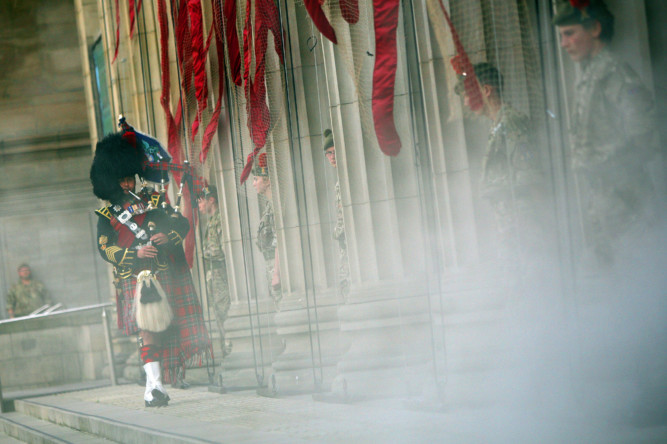Exactly 100 years ago 30,000 Scots went into battle. Many did not return.
Of the 72 British infantry divisions taking part in the first phase of the battle of Loos in northern France, half were Scottish.
Of the 20,598 names of the dead on the memorial at Loos, no less than one third are Scottish.
No part of our country was unaffected.
The Black Watch had massive casualties, the 9th alone lost 680 in the first few hours of fighting.
Of the 950 men of the 6th Cameronians who went into battle, 700 were casualties.
On the Loos memorial there are 678 names of the Gordon Highlanders, 697 from the Highland Light Infantry and 671 names from the King’s Own Scottish Borders.
As the battle was fought over coal mined ground which remained contested until the war ended three long years later, it proved impossible to recover and identify many of the fallen.
Their graves are inscribed “known unto God” while thousands of names of the servicemen missing in action with no known grave are inscribed on 139 stone panels around the memorial.
To put these casualty figures into context a division was composed of around 700 to 800 fighting men going “over the top”.
All of this sacrifice achieved little or nothing in military terms. The battle had no strategic significance beyond teaching lessons that were then effectively ignored by the British high command in the larger and bloodier battles to come on the Somme and, for Scotland, Arras in 1917.
The lessons of Loos were about the limitations of what could be achieved by attack in trench warfare.
It proved difficult to permanently overrun heavily reinforced positions, bombardment was generally ineffective but prevented any degree of surprise, the results from the first British poisonous gas attacks were variable and wind dependent, the complex logistics of efficiently mobilising reserves to the front line proved challenging, the inevitable confusion of controlling vast numbers of men amid the fog of war and then there was the grim reality of the appalling casualties which resulted from the machine gunning down of men on open ground.
The French high command were a disgrace to military service, the British were immobilised by being very much the junior partners in the front and the unseemly jockeying for position among the top brass.
The coming man was Douglas Haig who started the planning process for Loos more intelligently sceptical than any other senior officer about the prospects for success.
However, his scepticism did not stop the carnage nor did he learn from the slaughter that another “big push” was just as unlikely to yield victory.
Instead he allowed himself to be fooled by his own propaganda that the battle could have been won if only he had been in total command.
Loos ended in stalemate but Haig did succeed Field Marshal John French as Commander-in-Chief of the British Expeditionary Force.
This last weekend in Dundee,in the heart of Black Watch country, Loos took its proper part in the Scottish commemorations on the First World War.
These started with a drum head parade at Edinburgh Castle last year and will climax in just over three years with a recognition of the loss of the troop ship, The Iolaire, within touching distance of Stornoway Harbour on New Year’s Day 1919.
This Scottish commemorative programme has been designed to be respectful, to salute heroism and sacrifice of ordinary soldiers without in any way glorifying the futile bloodletting of the overall conflict.
On the contrary it is designed to educate a future generation in the reality of how their forbears in their own localities endured this total carnage.
There are only a few things in politics which make me really angry. One of them is when politicians, even now, talk carelessly about war or as the Prime Minister suggested in a speech in 2013 that we should celebrate the First World War “like the diamond jubilee”.
The Scottish commemorative programme is nothing at all like the diamond jubilee.
As a martial nation, Scots revere soldiers but have a healthy scepticism about military conflict.
Around this country there are war memorials, many now being properly and lovingly refurbished, which show the extent of the real and enduring impact on our nation the loss of our best blood on the slag heaps of Loos or the red chalk of Arras.
